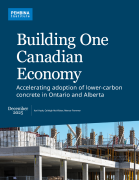At this time, like the rest of you, we at the Pembina Institute are witnessing the hardship COVID-19 is wreaking on families, our communities and economy, and we are inspired by the ways Canadians are coming together to tackle this global challenge. Our decisions today will ensure we are resilient to global challenges in the future. In this unprecedented time, we must all work together to ensure Canada emerges from this crisis more resilient and better positioned to succeed in a low-carbon, 21st-century economy.
With the COVID-19 pandemic at the forefront of our minds, we want to underscore the primary need to protect Canadians’ health and livelihoods, and applaud the swift and ongoing response from all levels of government to keep Canadians healthy and safe. We extend our gratitude to the front-line and essential workers who are risking their own well-being to respond to this crisis.
We see this moment as one of paramount importance for ensuring the health of Canadians and future resilience of our economy. Investments made today will define our well-being, competitiveness and economic strength in a decarbonizing global market, insulate our workers against future shocks and disruptions, and determine the success with which Canada reaches its 2050 net zero commitment.
Undeniably, massive financial injections are needed to help Canadians weather the ongoing health and economic crisis, and to stimulate Canada’s economy as we emerge from the pandemic. While financial relief for impacted Canadians should be immediate and wide-reaching, economic stimulus interventions, if designed with climate and economic resilience in mind, represent an extraordinary opportunity to simultaneously boost the economy in the short term and make a down payment on a prosperous, resilient future. Given public support for climate action, we strongly encourage staying the course on carbon pricing and gearing economic stimulus, including job protection and creation measures and funding, toward the clean energy transition.
We propose four guiding principles and a suite of specific recommendations for economic stimulus that support job maintenance and creation and climate action in the buildings, electricity, transportation (including zero-emission vehicles and batteries, hydrogen production and infrastructure, and transit), and oil and gas sectors. Together, by ensuring that our solutions to one crisis don’t exacerbate another, we can steer Canada’s economic recovery toward a cleaner, healthier, more resilient and prosperous future.
Download the PDF for full details; the overview and key recommendations are below.
Overview
With the COVID-19 pandemic at the forefront of our minds, we want to underscore the primary need to protect Canadians’ health and livelihoods, and applaud the swift and ongoing response from all levels of government to keep Canadians healthy and safe. We extend our gratitude to the front-line and essential workers who are risking their own well-being to respond to this crisis.
We see this moment as one of paramount importance for ensuring the health of Canadians and future resilience of our economy. Investments made today will define our well-being, competitiveness and economic strength in a decarbonizing global market, insulate our workers against future shocks and disruptions, and determine the success with which Canada reaches its 2050 net zero commitment.
Undeniably, massive financial injections are needed to help Canadians weather the ongoing health and economic crisis, and to stimulate Canada’s economy as we emerge from the pandemic. While financial relief for impacted Canadians should be immediate and wide-reaching, economic stimulus interventions, if designed with climate and economic resilience in mind, represent an extraordinary opportunity to simultaneously boost the economy in the short term and make a down payment on a prosperous, resilient future. Given public support for climate action, we strongly encourage staying the course on carbon pricing and gearing economic stimulus, including job protection and creation measures and funding, toward the clean energy transition.
While immediate financial relief is paramount for workers across all sectors of Canada’s economy, the following principles are integral to a stimulus response that ensures the future resilience of our economy:
- Priority should be given to funding that supports employment opportunities that are resilient to future economic shocks and disruption as the world seeks to limit warming to 1.5 degrees Celsius.
- Investments that support the development of industries and businesses producing low- and zero-carbon goods and services should be prioritized to grow the foundation for Canada’s low-carbon economy and secure our domestic supply chain.
- Investments in industry should incent decarbonization efforts that go beyond existing regulatory requirements.
- Where possible, all stimulus and relief decisions should be made through the lens of Canada’s ability to meet its climate commitments.
In this document, we articulate the importance of maintaining carbon pricing, provide specific recommendations for economic stimulus that supports job maintenance and creation and climate action in the buildings, electricity, transportation (including zero-emission vehicles and batteries, hydrogen production and infrastructure, and transit), and oil and gas sectors. Finally, we offer suggestions on existing channels to quickly disburse funds across Canada’s economy (including the Low Carbon Economy Fund, provincial energy efficiency agencies, Canada Infrastructure Bank, and others).
If acted upon, the following recommendations for a stimulus package will help steer economic recovery toward a cleaner, healthier, more resilient and prosperous future.
Key recommendations
On carbon pricing
- Stay the course on carbon pricing — do not defer or decrease — to ensure carbon emission reductions are delivered at the lowest possible cost and in a way that protects families through returned revenue and incentivizes behavioral changes and innovation.
For workers
- Along with immediate financial relief, make a significant funding investment in retraining for workers, including for:
- building professionals, contractors and trades to design and construct high-performance buildings and retrofit existing building stock;
- oil and gas workers to build expertise in clean technology that will lower carbon intensity in that sector, and to reposition them for careers in emerging low-carbon sectors like energy efficiency, clean technology, and renewable energy; and
- auto workers to join the zero-emission vehicle manufacturing economy.
On buildings
- Make a major nation-wide infrastructure investment in retrofits for existing buildings by increasing the Greener Home retrofit target and expanding it to include multi-unit residential buildings, using grants and loans to cover a significant portion of the retrofit cost.
- Co-finance deep retrofits of public and commercial buildings with a focus on schools, hospitals and social housing.
On electricity
- Achieve deep decarbonization of Canada’s electricity system through investment in updated infrastructure, adoption of clean energy technologies, improved connectivity between provinces, electrification of end uses, and small-scale renewable energy generation (including in remote communities).
On transportation
- Provide financial support for “sunrise industries” involved in providing and refining raw materials required for electric vehicle production (such as lithium mining) and for domestic research and development, manufacturing and assembly in the battery technology sector.
- Provide further tax cuts and other incentives for electric vehicle manufacturers and companies that develop and manufacture zero-emission technology.
- Invest in the commercial deployment of clean fuels and support for research and development and infrastructure (such as blender pumps and electric vehicle chargers).
- Invest in and help make financing available for hydrogen production and distribution, and invest in the science and technology required for the long-term build-out of affordable low-carbon hydrogen production from zero-carbon electricity, low-carbon feedstocks and water.
- Provide funding to ensure transit systems in Canada’s municipalities aren’t forced to reduce or suspend service, halt critical repairs, postpone green bus procurements and infrastructure, and/or raise fares to compensate for lost revenue during the pandemic.
On oil and gas
- Create a Green Transformation Program for the oil and gas sector, modelled on the 2009 federal pulp and paper transformation program, to help finance approved capital projects that would generate measurable environmental benefits in the area of energy efficiency and renewable energy, with criteria set by the federal government.
- Create a fund to support methane inventory work and mitigation measures that go beyond current regulatory requirements and with a preference for implementation of zero-emission mitigation measures (rather than incremental low-emission mitigation measures), backed by a requirement that companies prove methane emissions have been reduced and additional employment opportunities have been created.
- Provide loans with tight controls to those oil and gas companies with a proven ability to repay the loan to create employment opportunities to proactively address liabilities from abandoned wells.
- Provide funding to orphan well clean-up to address abandoned assets







